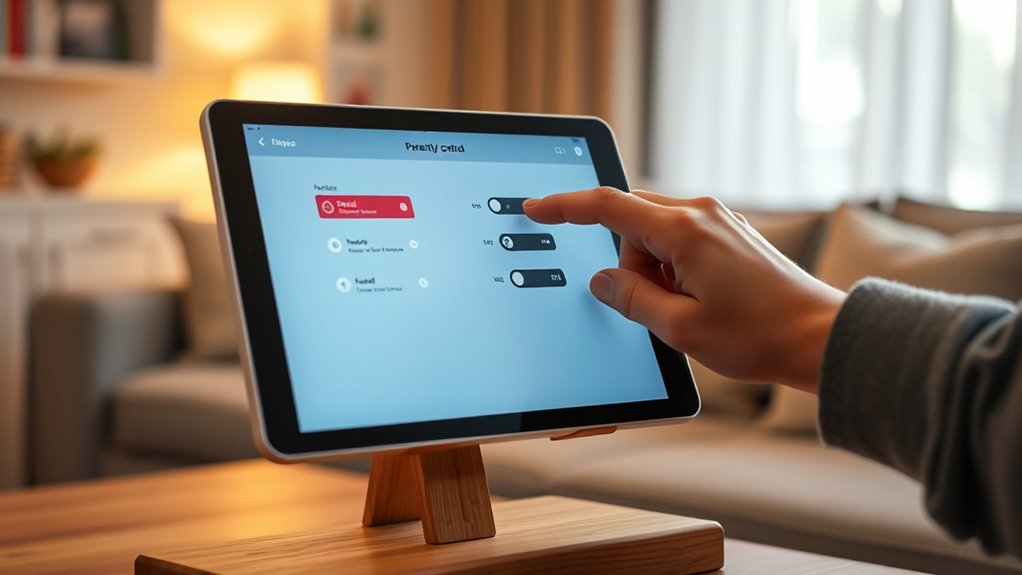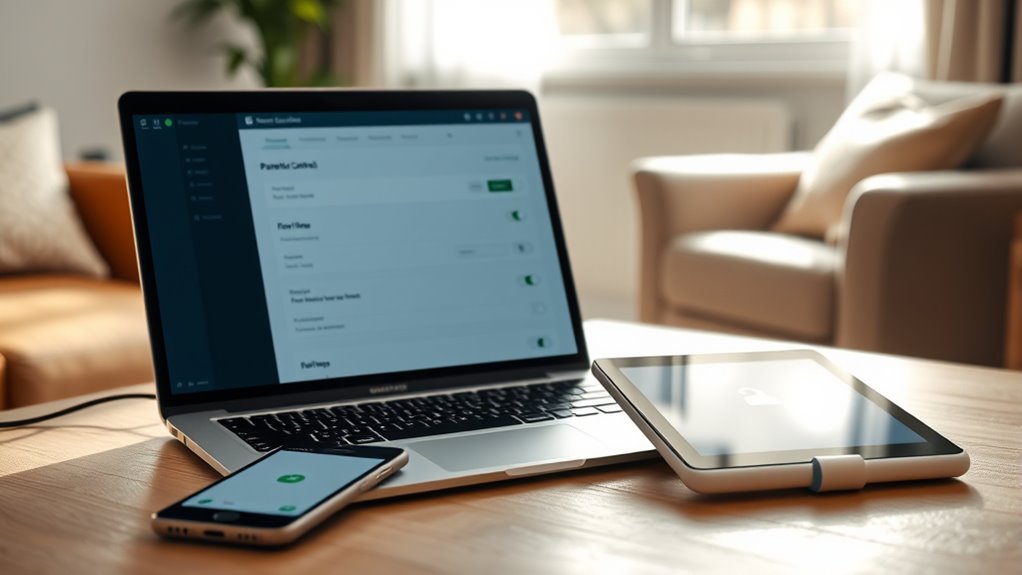To set up parental controls at home, start by exploring the built-in settings on your devices and internet provider options. Use these controls to manage screen time, block inappropriate content, and customize access based on your child’s age. Consider installing third-party apps for more thorough management. Explain these measures to your child to build trust, and actively supervise their online activities. Keep adapting the controls as your child grows to ensure ongoing safety, and if you keep exploring, you’ll find even more effective strategies.
Key Takeaways
- Access device settings or internet provider tools to enable built-in parental controls.
- Use third-party apps for comprehensive management of screen time and content filtering.
- Set clear rules and communicate expectations with your children about online use.
- Configure time limits and block inappropriate websites or apps based on age.
- Regularly review and update controls to adapt to your child’s growing needs.

Are you worried about your child’s online safety? Setting up parental controls at home is an essential step to ensure they navigate the internet securely. One of the most effective ways to do this is by implementing screen time management. By controlling how long your child spends online, you prevent excessive use that can interfere with their sleep, homework, and physical activity. Many devices and platforms allow you to set daily limits or schedules, making it easy to enforce healthy habits without constant supervision. When you establish clear boundaries, your child learns to balance their digital life with other important activities. Implementing easy document management tools can also help organize digital files related to their online activities, promoting responsible use. Content filtering is another critical feature of parental controls that helps protect your child from harmful or inappropriate content. With content filtering, you can block access to websites, apps, or keywords that aren’t suitable for their age. This is especially useful for preventing exposure to violence, explicit material, or misinformation. Most devices and internet providers offer customizable filtering options, so you can tailor restrictions based on your child’s age, maturity level, and specific concerns. Regularly reviewing and updating these filters ensures they remain effective as your child grows and encounters new online environments. Setting up parental controls might seem complicated at first, but many devices and platforms make it straightforward. Start by exploring the settings menu on your child’s device, whether it’s a tablet, smartphone, or computer. Many operating systems include built-in parental control features that allow you to manage screen time and content filtering directly. You can also leverage third-party apps that offer more comprehensive control over multiple devices from a single dashboard. When configuring these controls, be transparent with your child about the reasons behind them. Explaining that these measures are designed to keep them safe fosters trust and encourages responsible usage. In addition to technical controls, it’s essential to set clear rules and expectations. Talk openly about what types of content are acceptable and why limits are necessary. Encourage your child to come to you if they encounter anything upsetting or confusing online. Combining technical safeguards with ongoing communication builds a safer digital environment and helps your child develop good online habits. Remember, parental controls are tools to assist your guidance—they shouldn’t replace active engagement and supervision. By actively managing screen time and filtering content, you’re taking key steps to protect your child and help them develop a balanced, safe approach to technology use.
Frequently Asked Questions
Can Parental Controls Be Bypassed by Tech-Savvy Children?
Yes, tech-savvy children can sometimes bypass parental controls if they know enough about the devices or networks. They might use VPNs, proxy sites, or other tricks to dodge restrictions. To stay ahead, you should regularly update controls, monitor activity, and have open conversations about responsible internet use. Staying vigilant makes it harder for tech-savvy children to bypass parental controls and helps keep your kids safe online.
How Often Should I Review My Parental Control Settings?
You should review your parental control settings regularly, ideally every few months. This monitoring frequency helps you stay aware of your child’s online activity and guarantees controls are effective. Adjust the timing as needed—when your child’s interests change or new apps appear. Frequent reviews keep the restrictions relevant and prevent tech-savvy children from bypassing them, keeping your child’s online experience safe and appropriate.
Are Parental Controls Effective Across All Devices?
Parental controls are generally effective across most devices, but their effectiveness depends on device compatibility and control limitations. You should check if the controls you set up work seamlessly on all your child’s devices, including smartphones, tablets, and computers. Keep in mind that some controls may have limitations, so regularly reviewing and updating settings ensures better protection. Always verify that controls are functioning correctly on each device for maximum safety.
What Should I Do if My Child Finds a Way Around Controls?
If your child finds a way around controls, talk openly about digital literacy and responsible internet use. Explain why these restrictions are in place and encourage honesty. Reinforce trust by discussing online safety and setting clear expectations. Keep communication ongoing, and consider adjusting controls as your child matures. Staying engaged and fostering open dialogue helps them understand limits and develop healthy digital habits.
Do Parental Controls Impact Device Performance or User Experience?
Parental controls typically don’t impact device speed or user interaction considerably. You might notice minor delays during certain filtering processes, but overall, your device’s performance remains smooth. These controls mainly influence user interaction by guiding or restricting access to content, which can make browsing safer for your child. Properly configured controls ensure a balanced experience, allowing your child to use the device effectively while maintaining security and control.
Conclusion
By setting up parental controls, you’re building a sturdy shield around your child’s online world. Think of it as planting a garden—carefully choosing what’s allowed to grow and keeping out weeds. With these tools in place, you’ll nurture a safer digital environment where your kids can explore and learn without unnecessary risks. Remember, your guidance is the compass that helps them navigate the online seas safely. So, take action today and steer your family towards safer surfing.









